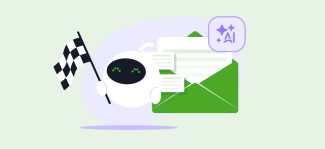How to re-engage inactive subscribers
When you dream about your perfect email list, the chances are inactive subscribers don’t feature. But this is the real world, not the fantasy land. Inactive subscribers are always going to be something to deal with over time.
Even the best customers can grow dormant as their life changes and needs morph from one thing to another. When this happens, there’s a couple of different ways you can react.
Get rid of them!
There’s a school of thought that says inactive subscribers should be removed from your list to avoid problems like deliverability issues. Firing off lots of emails to inactive customers can hurt because email clients are more inclined to mark your messages as spam if the open rate is poor.
Nobody wants to spend all that time creating the best email marketing campaigns to see it go to waste - and even worse - actively work against them!
Nurture them!
However, you could always try to turn these people back on your side. These are all folks who signed up to your list for a reason, right? So it would make sense to try and get them to see why your experience is so awesome for a second time!
After all, it’s five times more expensive to find a new customer than to sell to an existing one! If you have a clean opt-in practise, and that means using double opt-in as part of the mailing list sign up process, and regularly monitor your campaigns then you should be able to try to re-engage these lapsed customers without it having a negative impact on deliverability.
Re-engage email subscribers!

There’s definitely going to be a time and a place where you should consider re-engaging email subscribers. Here’s why:
- Your subscribers joined for a reason
- Each subscriber represents money that can be made
- Re-engaging those people is a smart move regardless
Every business will go through stages where they have dormant or unengaged subscribers. These are people who were previously active, but have started to slow down their engagement with you.
Because these people are sitting on the fence, they should be targeted with re-engagement strategies to try and get them back on side.
This is where you’ll need to use marketing automation, and in particular, re-engagement flows if you want to find the results you need. And try to bring back those who’ve got away.
Create dynamic profiles
First, you’ll need to identify the users you want to target and create a segment for each type of inactive subscriber. These could be periodically inactive, or historically inactive.
You’ll need to have a solid content plan and create at least three emails to send to each inactive subscriber. Because only a small percentage of people will engage with your first win-back email, you need to be a little persuasive.
Have a strong idea of what you can offer within the email. Because you deal in amazing experiences, you’ve already got a strong selling point! But sometimes that activity of a lifetime can be expensive, so you can offer small discounts or throw in a little extra for free to make that bit more tempting.
It’s also important to note that you should spread your emails out a little bit to avoid bombarding people - that’s the easiest way to turn someone off your brand!
There are different types of subscribers that could be targeted in this way:
- Sleepy subscribers. These used to be engaged but have entered this in-between period that leaves you considering whether they’ll be back or not. These ones generally have the most potential to re-engage.
You’ll want to get on to each of these subscribers as quickly as possible because they’re at risk of slipping off and becoming beyond your reach.
- Zombies. These are the type of subscribers that probably aren’t going to come back because they’ve been away for so long, but you may as well try to bring them back. You should ramp down your communications with these subs over time as you send fewer and fewer emails until you stop.
Personalise your comms

Regardless of who you’re attempting to win-back, the key thing is to use all that marketing automation power to create personalised communications. This is so important - businesses do it because personalisation = higher revenues.
When you break down your email list into segments and profiles, you’ll be able to target people based on their behaviours and personal information. This means you can speak to their soul in a way that wouldn’t be possible without marketing automation.
You should also take into account their history with your business. It might go a little something like this: You are a theme park with a really great email marketing scheme and you’re prepping for the summer rush. You could target people based on how many times they’ve visited your park over the past 24 months - those frequent customers could receive an early-bird discount or a loyalty bonus.
An events company that specialises in running massive music festivals might team up with travel operators to offer non-local music fans travel plus ticket options - something that wouldn’t be as important for customers closer to town.
Other things to consider could be how many times have they booked with you? Are they an international traveller? Have they booked travel and hospitality or just events and days out? There are so many different options to consider with how different people interact with your brand - some might go for a full package while others will be happy to book certain aspects themselves. These are all important things to think about. Data can provide the answers.
Gather data
To do all of this, you need the right data. That means you need to be offering a double opt-in to make sure subscribers really want to be contacted - it also means you can grab extra data from them.
Also, don’t be shy to ask questions. Use surveys to ask for preferences, and if someone wants to unsubscribe, you can always ask why and use that to inform future decisions.
Clean your list with unsubscribe emails
So that’s re-engagement dealt with. Sadly, there are people who are just never going to respond to that - but there’s something that can be done with them.
That something is removal! It’s best just to cut your losses with these subscribers and get them off your mailing list. A clean list will result in a higher open rate and improved metrics, so it’s not all doom and gloom.
You could cull your inactive profiles manually, or you could send them an unsubscribe email. This is really useful if you need to update your system automatically.
An unsubscribe email is an email that directs inactive subscribers somewhere they can easily unsubscribe from your list, which’ll help you practise good list hygiene and consent practices.
Don’t give up

As we’ve read, it’s really important not to throw in the towel straight away. There’s a large portion of inactive subscribers that can be targeted with re-engagement emails, and that should be part of your content strategy.
It costs so much more to find new customers than it does to sell to an existing one, so it makes sense that you don’t clear out your mailing list as soon as someone stops being responsive. Rather, look to hit them with a tailored campaign. And, at the end of it all, you can always send an unsubscribe email to those who refuse to engage.
At least this way you’ll limit your chances of falling into a spam trap, will be able to keep a clean list and give yourself the chance of earning some extra revenue.


